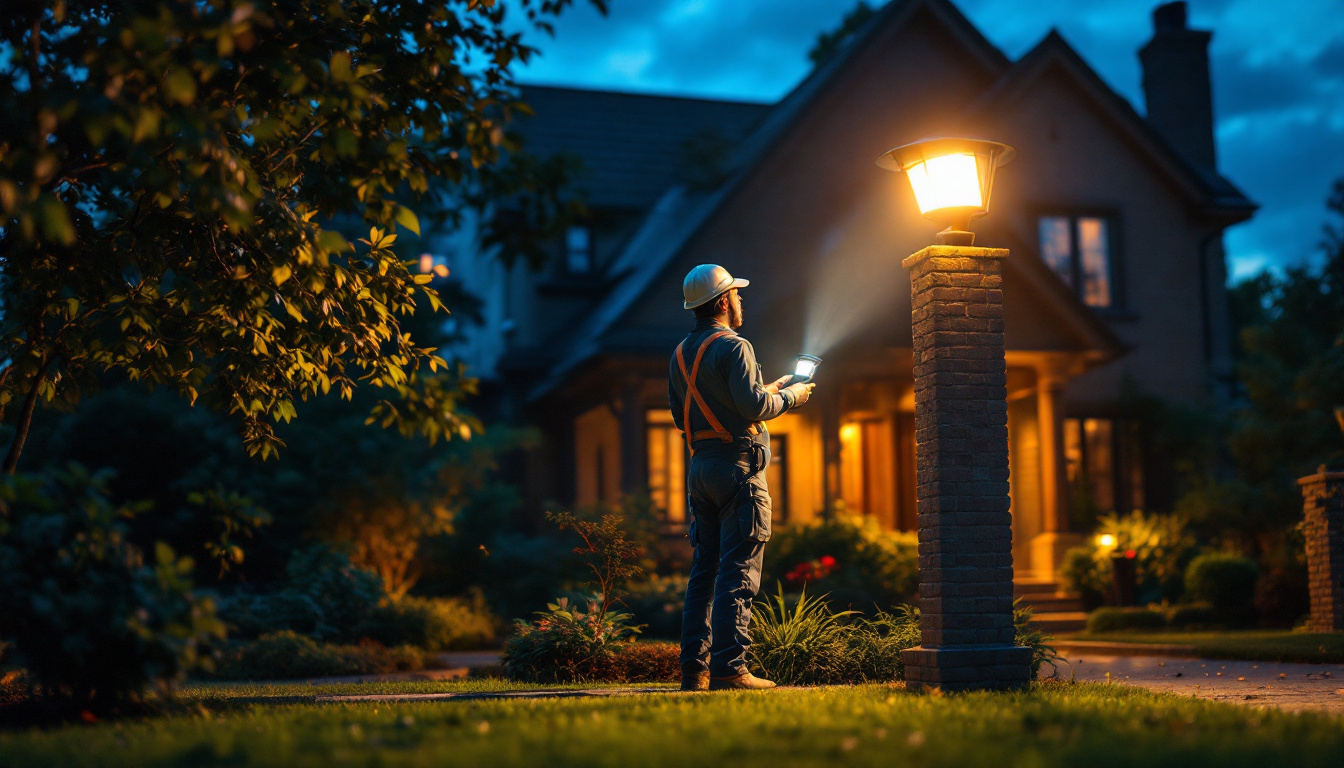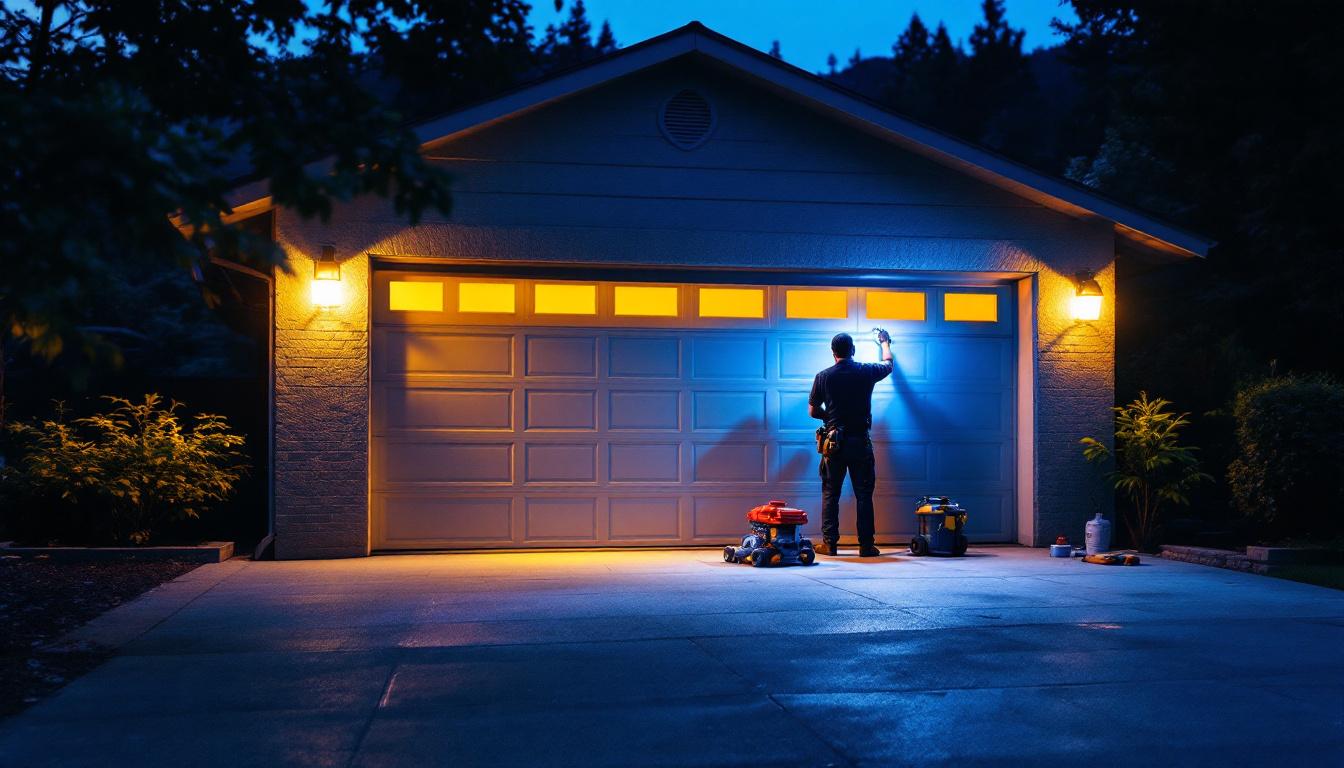
In the ever-evolving world of outdoor lighting, motion sensor floodlights have emerged as a revolutionary solution for lighting contractors. These innovative fixtures not only enhance security but also provide energy efficiency and convenience, making them an essential addition to any contractor’s toolkit. This article explores the benefits, applications, and installation considerations of motion sensor floodlights, shedding light on why they are a game-changer in the industry.
Motion sensor floodlights utilize advanced technology to detect movement within a designated area. By employing passive infrared (PIR) sensors or dual technology sensors, these lights can activate automatically when they detect motion, providing illumination only when needed. This not only conserves energy but also enhances safety and security in residential and commercial settings. The ability to customize the sensitivity and duration of illumination further allows users to tailor the system to their specific needs, ensuring optimal performance and efficiency.
There are primarily two types of motion sensors used in floodlights: passive infrared (PIR) sensors and dual technology sensors. PIR sensors detect changes in infrared radiation, which is emitted by moving objects, such as people or animals. This type of sensor is widely used due to its reliability and cost-effectiveness. They are particularly effective in outdoor settings, where they can cover large areas and provide a wide field of view, making them suitable for driveways, backyards, and commercial properties.
On the other hand, dual technology sensors combine PIR technology with microwave sensors, which emit microwave signals to detect motion. This combination increases sensitivity and reduces false alarms, making dual technology sensors ideal for areas with high foot traffic or varying environmental conditions. For instance, in environments where wind can cause branches to sway, dual technology sensors can differentiate between harmless movements and actual intruders, ensuring that the lights activate only when necessary.
For lighting contractors, the advantages of installing motion sensor floodlights are manifold. One of the most significant benefits is energy efficiency. Traditional floodlights operate continuously, consuming power even when there is no activity in the area. In contrast, motion sensor floodlights activate only when needed, significantly reducing energy consumption and lowering utility bills for clients. This energy-saving feature not only benefits the environment but also appeals to eco-conscious consumers looking to reduce their carbon footprint.
Additionally, these lights enhance security by illuminating dark areas when movement is detected. This sudden burst of light can deter potential intruders, making properties safer. Furthermore, the convenience of automatic activation means homeowners and business owners do not have to worry about manually turning on lights, especially during late-night hours. Many modern motion sensor floodlights also come equipped with adjustable settings that allow users to control the range and sensitivity of the sensors, providing even greater flexibility. Some models even include smart technology integration, enabling users to monitor and control their lighting systems remotely via smartphone apps, adding another layer of convenience and control to their security measures.
Motion sensor floodlights are versatile and suitable for various applications, making them an attractive option for lighting contractors. From residential properties to commercial spaces, these lights can be installed in numerous locations to enhance safety and functionality.
In residential settings, motion sensor floodlights are commonly installed in driveways, backyards, and entryways. They provide homeowners with peace of mind, knowing that their property is well-lit when someone approaches. This is particularly beneficial for families with children or elderly residents, as it reduces the risk of accidents in dark areas.
Moreover, these lights can be integrated with smart home systems, allowing homeowners to control them remotely via smartphone apps. This added level of convenience appeals to tech-savvy clients who prioritize modern solutions in their homes.
For commercial and industrial applications, motion sensor floodlights are invaluable in enhancing security and safety. Businesses can install these lights in parking lots, loading docks, and outdoor storage areas to ensure that these spaces are well-lit during non-business hours. This not only protects assets but also provides a safer environment for employees working late shifts.
Additionally, motion sensor floodlights can be utilized in public spaces such as parks and recreational areas, where safety is a top priority. By illuminating pathways and gathering spaces, these lights help to create a welcoming environment for visitors while deterring criminal activity.
While the benefits of motion sensor floodlights are clear, proper installation is crucial to maximize their effectiveness. Lighting contractors must consider several factors when planning and executing an installation project.
Choosing the right location for motion sensor floodlights is essential. Contractors should assess the area to determine where movement is most likely to occur and ensure that the sensors have a clear line of sight. Installing lights at strategic points can enhance coverage and reduce blind spots, providing optimal security for the property.
It is also important to consider the range and sensitivity of the sensors. Different models have varying detection ranges, so contractors should select lights that meet the specific needs of the installation site. Adjusting the sensitivity settings can help minimize false alarms caused by small animals or environmental factors.
Proper wiring and power supply are critical components of any lighting installation. Contractors should ensure that the floodlights are connected to a reliable power source and that wiring is compliant with local electrical codes. Utilizing weatherproof fixtures and connectors can enhance the longevity and safety of the installation, especially in outdoor environments.
Additionally, integrating motion sensor floodlights with existing lighting systems can provide a cohesive solution. Contractors should evaluate whether to use standalone units or connect them to a centralized control system for seamless operation.
To ensure the longevity and effectiveness of motion sensor floodlights, regular maintenance is essential. Lighting contractors should educate clients on the importance of keeping the fixtures clean and free from obstructions that could hinder sensor performance.
Over time, dirt, dust, and debris can accumulate on the sensors and lenses, affecting their ability to detect motion. Regular cleaning can help maintain optimal performance. Contractors can recommend a cleaning schedule to clients, emphasizing the importance of inspecting the fixtures periodically for any signs of wear or damage.
In addition to cleaning, contractors should encourage clients to check the sensitivity settings and adjust them as needed. Environmental changes, such as new landscaping or construction, may require recalibrating the sensors to ensure they function effectively.
Despite their reliability, motion sensor floodlights may encounter issues from time to time. Contractors should be prepared to troubleshoot common problems, such as false alarms or lights not activating. Understanding the potential causes of these issues can help contractors provide effective solutions.
For instance, if a floodlight is frequently activating without any detected motion, it may be due to environmental factors, such as wind or passing vehicles. Adjusting the sensitivity settings or repositioning the light may resolve the issue. Conversely, if the lights do not activate at all, checking the power supply and wiring connections is a crucial first step in diagnosing the problem.
The lighting industry is constantly evolving, and motion sensor floodlights are no exception. As technology advances, new features and capabilities are being integrated into these fixtures, making them even more appealing to lighting contractors and their clients.
One of the most significant trends in motion sensor floodlights is the integration of smart technology. Many manufacturers are now offering models that can be controlled via smartphone apps or voice-activated systems. This allows homeowners to customize settings, receive notifications, and even monitor activity in real-time from anywhere.
Smart motion sensor floodlights can also be programmed to work in conjunction with other smart home devices, such as security cameras or alarm systems. This interconnectedness enhances overall security and provides a comprehensive solution for homeowners looking to protect their properties.
As energy efficiency continues to be a priority for consumers, manufacturers are developing motion sensor floodlights that utilize LED technology. LED lights not only consume less energy but also have a longer lifespan compared to traditional incandescent bulbs. This shift towards energy-efficient solutions aligns with the growing demand for sustainable practices in the lighting industry.
Moreover, advancements in solar-powered motion sensor floodlights are gaining popularity. These fixtures harness solar energy during the day and provide illumination at night, reducing reliance on the electrical grid and further promoting sustainability.
Motion sensor floodlights represent a transformative advancement in outdoor lighting, offering numerous benefits for lighting contractors and their clients. With their energy efficiency, enhanced security features, and versatility in applications, these fixtures are becoming an essential component of modern lighting solutions.
As technology continues to evolve, the potential for motion sensor floodlights will only expand, providing contractors with exciting opportunities to enhance their service offerings. By staying informed about the latest trends and installation best practices, lighting contractors can position themselves as leaders in the industry, ready to meet the growing demand for innovative lighting solutions.
Incorporating motion sensor floodlights into project portfolios not only improves client satisfaction but also contributes to a safer and more energy-efficient environment. Embracing this technology is not just a trend; it’s a strategic move that can lead to long-term success in the competitive landscape of lighting contracting.
Ready to elevate your lighting projects with the cutting-edge efficiency and security of motion sensor floodlights? At LumenWholesale, we provide lighting contractors with the highest quality, spec-grade lighting solutions at unbeatable wholesale prices. Our extensive selection of motion sensor floodlights meets rigorous industry standards, ensuring you deliver reliable and high-performance lighting to your clients. Take advantage of our hassle-free bulk buying and free shipping to get premium lighting at the best value — without hidden fees. Make your next project shine brighter by choosing Wholesale Lighting at the Best Value with LumenWholesale.

Discover the top strategies lighting contractors use to optimize AC lighting systems for efficiency and aesthetics.

Discover how garage lamp fixtures can revolutionize the workflow for lighting contractors, offering significant time and cost savings.

Discover what sets top lighting contractors apart in outdoor garage lights LED installation.

Discover how LED strip lights can revolutionize warehouse lighting with energy efficiency and cost savings.